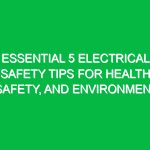Introduction
Good morning, team! Today, we’re gathered for our Toolbox Talk to discuss a crucial topic that affects our daily operations: Pressure Washing Safety. As we prepare to tackle our tasks, it’s vital that we understand the potential Hazards associated with pressure washing and how we can mitigate these risks to ensure a safe working Environment. By following the Best Practices we discuss today, we can protect not only ourselves but also our coworkers and the public. Let’s dive into the essential pressure washing Safety tips that will help us work smart and stay safe.
Understanding Pressure Washing Safety
Pressure washing is a powerful tool. It utilizes high-pressure water jets to clean surfaces, but with great power comes great responsibility. Understanding Pressure Washing Safety involves recognizing the risks involved, such as injuries from the high-pressure water, slips and falls, and exposure to hazardous materials. In this section, we’ll break down these risks and how to address them.
The Risks of Pressure Washing
- Injury from High Pressure: The most immediate risk of pressure washing is injury caused by the high-pressure water stream. It can penetrate the skin, causing serious injuries.
- Slips and Falls: Water and cleaning agents can create slippery surfaces, increasing the risk of falls.
- Exposure to Chemicals: Many cleaning solutions used in pressure washing can be toxic or irritating to the skin and eyes.
- Electric Shock: If using electric-powered pressure washers, there is a risk of electric shock, especially in wet conditions.
Key Safety Precautions
Now that we understand the risks, let’s discuss some key safety Precautions to implement before and during our pressure washing tasks.
Personal Protective Equipment (PPE)
Wearing appropriate PPE is the first line of defense against injuries. Here are the essential items you should have:
- Safety Goggles: Protect your eyes from debris and chemicals.
- Gloves: Use chemical-resistant gloves to prevent skin irritation.
- Long-Sleeve Shirts and Pants: These provide a barrier against chemicals and potential injuries from the high-pressure water.
- Slip-Resistant Boots: Ensure you have footwear that provides good traction to prevent slips.
- Hearing Protection: If the machine is particularly loud, consider using ear protection.
Equipment Inspection
Before starting your pressure washing tasks, it’s vital to inspect your equipment. Here’s what you should check:
- Hoses and Connections: Look for cracks or leaks that could lead to accidents.
- Nozzle Condition: Ensure nozzles are clean and functioning properly to avoid dangerous spray patterns.
- Electrical Cords: Check for frays or damage to avoid electric shock.
Site Assessment
Conduct a thorough assessment of the work area. Identify potential Hazards, such as:
- Overhead power lines that could pose a risk while washing.
- Wet surfaces that could lead to slips and falls.
- Bystanders or obstacles in the area that could impede safe Operation.
Best Practices During Operation
With our equipment ready and our site assessed, let’s talk about Best Practices during operation to ensure Pressure Washing Safety.
Safe Operating Procedures
- Maintain a Safe Distance: Always stand a safe distance from the surface being washed to avoid injury from the high-pressure stream.
- Use the Right Nozzle: Different nozzles create different pressure levels. Use the appropriate nozzle for the task to avoid damaging surfaces or causing injury.
- Control the Spray Direction: Always point the nozzle away from yourself and others, and avoid spraying at an angle that could cause the water to ricochet.
- Stay Aware of Your Surroundings: Keep an eye on your coworkers and potential hazards as you work.
Handling Chemicals Safely
If you’re using cleaning agents, it’s essential to handle them properly:
- Read Labels: Always read and understand the safety data sheets (SDS) for any chemicals you’re using.
- Use in Well-Ventilated Areas: If possible, ensure you’re working in an area with good ventilation to avoid inhaling fumes.
- Store Chemicals Properly: Keep chemicals in their original containers and store them out of reach of unauthorized personnel, especially children.
Emergency Procedures
Despite our best efforts, accidents can happen. It’s crucial to have emergency procedures in place:
First Aid Procedures
Be familiar with first aid procedures for common injuries associated with pressure washing:
- Skin Injuries: If someone is hit by the pressure washer, seek medical attention immediately, even for minor injuries, as they can lead to infections.
- Eye Injuries: If chemicals or debris get in the eyes, rinse them immediately with water and seek medical help.
- Electrical Shock: If someone experiences electric shock, do not touch them until the power source is turned off, then call for help.
Reporting Incidents
Always report any incidents, no matter how minor. This helps us learn and prevent future accidents. Make sure you know the proper channels for reporting incidents within our organization.
Training and Regulations
It’s essential to stay informed about safety regulations and Training requirements relevant to Pressure Washing Safety. Here are some key points:
Regulations and Compliance
Familiarize yourself with OSHA regulations and any company-specific policies regarding pressure washing. Compliance not only enhances safety but also fulfills legal obligations.
Ongoing Training
Participate in ongoing training sessions to stay updated on the latest safety practices. This includes refresher courses on equipment operation and the handling of hazardous materials.
Real-Life Examples and Scenarios
To illustrate the importance of Pressure Washing Safety, let’s discuss a couple of hypothetical scenarios:
Scenario 1: High-Pressure Injury
Imagine a coworker is pressure washing a concrete surface and accidentally points the nozzle at their leg. They suffer a deep cut. This incident could have been avoided by maintaining a safe distance and using the correct spray angle. Always remember: Safety First!
Scenario 2: Chemical Exposure
Another scenario involves a worker using a chemical cleaner without proper PPE. They experience skin irritation that leads to a medical visit. This highlights the importance of wearing gloves and goggles when handling chemicals.
Discussion and Engagement
Before we conclude, I’d like to open the floor for discussion. What safety practices do you currently follow when pressure washing? Have you encountered any challenges or near-misses that we should discuss? Your input is invaluable in fostering a culture of safety.
Conclusion
In summary, Pressure Washing Safety is not just a set of guidelines; it is a commitment we make to ourselves and our colleagues. By adhering to the practices discussed today—wearing proper PPE, inspecting equipment, assessing our worksite, and being prepared for emergencies—we can significantly reduce the risks associated with our tasks. Thank you for your attention and for your commitment to maintaining a safe work environment. Let’s make safety a priority in all our operations!


